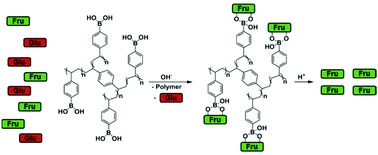当前位置:
X-MOL 学术
›
Green Chem.
›
论文详情
Our official English website, www.x-mol.net, welcomes your feedback! (Note: you will need to create a separate account there.)
Structure-performance correlations of cross-linked boronic acid polymers as adsorbents for recovery of fructose from glucose–fructose mixtures
Green Chemistry ( IF 9.8 ) Pub Date : 2019/12/16 , DOI: 10.1039/c9gc03151k Guido Schroer 1, 2, 3, 4 , Jeff Deischter 1, 2, 3, 4 , Tobias Zensen 1, 2, 3, 4 , Jan Kraus 4, 5, 6, 7 , Ann-Christin Pöppler 4, 5, 6, 7 , Long Qi 8, 9, 10, 11 , Susannah Scott 11, 12, 13, 14, 15 , Irina Delidovich 1, 2, 3, 4
Green Chemistry ( IF 9.8 ) Pub Date : 2019/12/16 , DOI: 10.1039/c9gc03151k Guido Schroer 1, 2, 3, 4 , Jeff Deischter 1, 2, 3, 4 , Tobias Zensen 1, 2, 3, 4 , Jan Kraus 4, 5, 6, 7 , Ann-Christin Pöppler 4, 5, 6, 7 , Long Qi 8, 9, 10, 11 , Susannah Scott 11, 12, 13, 14, 15 , Irina Delidovich 1, 2, 3, 4
Affiliation

|
Recovery of bio-oxygenates from reaction mixtures is one of the major challenges for future bio-refineries. Isolation of fructose produced by isomerization of glucose presents a typical example at a very early stage of the value chain. We propose to recover fructose from a solution containing a mixture of glucose and fructose by adsorption on polymers bearing phenylboronate moieties. p-Vinylphenylboronic acid was polymerized with various cross-linkers, namely polar aliphatic, low-polarity aliphatic, and aromatic. The cross-linker content was in the range 5–40 mol%. The polymers exhibit high capacities for fructose, with a maximum loading of up to 1 molFru molB−1. Fructose loading depends significantly on the length and content of cross-linker, as well as pre-treatment of the polymer. In general, the maximum fructose capacity correlates with the swelling ability of the polymers, since phenylboronate moieties become available for adsorption upon swelling. In contrast, maximum glucose loadings are much lower, in the range 0.1–0.3 molGlu molB−1, and depend only slightly on the type of cross-linker. The structures of the glucose and fructose complexes and the kinetics of their uptake were studied by in situ MAS NMR. Efficient desorption of fructose was observed in acidic medium, and more importantly, using CO2. The structures of the polymers after repeated adsorption and desorption remain unchanged, as confirmed by solid-state NMR. Adsorption-assisted isomerization of glucose catalyzed by soluble carbonates was also studied. A 56% yield of fructose was achieved after 8 successive cycles of reaction and adsorption.
中文翻译:

交联硼酸聚合物作为吸附剂从葡萄糖-果糖混合物中回收果糖的结构性能相关性
从反应混合物中回收生物含氧化合物是未来生物精炼厂的主要挑战之一。葡萄糖异构化产生的果糖的分离是价值链非常早期的一个典型例子。我们建议通过吸附在带有苯基硼酸酯部分的聚合物上,从含有葡萄糖和果糖的混合物的溶液中回收果糖。对乙烯基苯硼酸与各种交联剂聚合,即极性脂族,低极性脂族和芳族。交联剂的含量在5-40 mol%的范围内。聚合物显示出高果糖容量,最大负载量高达1 mol Fru mol B -1。果糖负载量很大程度上取决于交联剂的长度和含量以及聚合物的预处理。通常,最大果糖容量与聚合物的溶胀能力相关,因为苯硼酸酯部分在溶胀时变得可用于吸附。相反,最大葡萄糖负载量要低得多,在0.1–0.3 mol Glu mol B -1范围内,并且仅略微取决于交联剂的类型。葡萄糖和果糖复合物的结构及其吸收动力学通过原位MAS NMR进行了研究。在酸性介质中观察到了果糖的有效解吸,更重要的是,使用了CO 2。如通过固态NMR所证实的,在重复吸附和解吸之后,聚合物的结构保持不变。还研究了可溶性碳酸盐催化的葡萄糖的吸附辅助异构化。在连续8个反应和吸附循环后,果糖的产率为56%。
更新日期:2020-02-10
中文翻译:

交联硼酸聚合物作为吸附剂从葡萄糖-果糖混合物中回收果糖的结构性能相关性
从反应混合物中回收生物含氧化合物是未来生物精炼厂的主要挑战之一。葡萄糖异构化产生的果糖的分离是价值链非常早期的一个典型例子。我们建议通过吸附在带有苯基硼酸酯部分的聚合物上,从含有葡萄糖和果糖的混合物的溶液中回收果糖。对乙烯基苯硼酸与各种交联剂聚合,即极性脂族,低极性脂族和芳族。交联剂的含量在5-40 mol%的范围内。聚合物显示出高果糖容量,最大负载量高达1 mol Fru mol B -1。果糖负载量很大程度上取决于交联剂的长度和含量以及聚合物的预处理。通常,最大果糖容量与聚合物的溶胀能力相关,因为苯硼酸酯部分在溶胀时变得可用于吸附。相反,最大葡萄糖负载量要低得多,在0.1–0.3 mol Glu mol B -1范围内,并且仅略微取决于交联剂的类型。葡萄糖和果糖复合物的结构及其吸收动力学通过原位MAS NMR进行了研究。在酸性介质中观察到了果糖的有效解吸,更重要的是,使用了CO 2。如通过固态NMR所证实的,在重复吸附和解吸之后,聚合物的结构保持不变。还研究了可溶性碳酸盐催化的葡萄糖的吸附辅助异构化。在连续8个反应和吸附循环后,果糖的产率为56%。



























 京公网安备 11010802027423号
京公网安备 11010802027423号